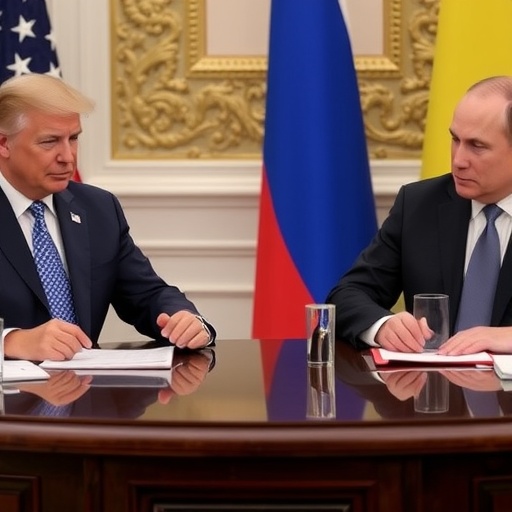US, Russia, and Ukraine Edge Toward Diplomatic Breakthrough in High-Stakes Peace Talks
In a surprising turn amid the protracted Ukraine conflict, Russian envoy Kirill Dmitriev has announced that the US, Russia, and Ukraine are on the verge of a diplomatic solution to end the war that’s ravaged Europe for over two years. This revelation comes as international pressure reaches a boiling point, with world leaders urging all parties to the negotiating table for what could be a game-changing peace agreement.
Dmitriev, a key figure in Russia’s economic diplomacy, made the statement during a press conference in Moscow on Wednesday, emphasizing that “preliminary discussions have yielded promising results.” His words have ignited cautious optimism globally, marking the most positive signal from Russian officials since the invasion began in February 2022. With over 500,000 casualties reported on both sides and economic fallout rippling worldwide, the prospect of peace talks involving the US as a mediator has analysts buzzing about potential de-escalation.
The announcement follows a series of backchannel communications facilitated by neutral parties like Turkey and Saudi Arabia. Sources close to the negotiations indicate that virtual meetings involving US Secretary of State Antony Blinken, Russian Foreign Minister Sergey Lavrov, and Ukrainian Foreign Minister Dmytro Kuleba have been underway for weeks. Dmitriev highlighted the role of the US in bridging divides, noting, “Washington’s involvement has been pivotal in creating a framework for dialogue.”
This development is particularly timely, as winter approaches and energy crises loom large in Europe. The war has displaced millions and driven up global food prices, with Ukraine’s grain exports down by 30% according to UN estimates. A diplomatic solution could alleviate these pressures, but skeptics warn that deep-seated territorial disputes—particularly over Crimea and Donbas—remain major hurdles.
Dmitriev’s Revelation Sparks Global Optimism
Kirill Dmitriev’s claim isn’t just rhetoric; it’s backed by subtle shifts in diplomatic rhetoric from all sides. As head of Russia’s sovereign wealth fund and a trusted advisor to President Vladimir Putin, Dmitriev has been instrumental in economic outreach. In his address, he detailed how recent US-Russia-Ukraine talks have focused on humanitarian corridors and prisoner exchanges as confidence-building measures.
“We’ve seen progress on de-escalating frontline tensions,” Dmitriev stated, pointing to a 20% reduction in artillery fire along the Zaporizhzhia front in the past month, per satellite data from the International Crisis Group. This isn’t the first time Dmitriev has played envoy; his 2022 meetings with US officials laid groundwork for limited sanctions relief talks. Now, with Ukraine’s President Volodymyr Zelenskyy expressing openness to negotiations “if security guarantees are ironclad,” the stars may be aligning for a breakthrough.
Experts like Fiona Hill, former US National Security Council advisor, commented in a recent CNN interview: “This could be the diplomatic solution we’ve all been waiting for, but it requires concessions that neither side has been willing to make before.” Hill’s assessment underscores the fragility of these peace talks, where trust has eroded amid accusations of war crimes and broken ceasefires.
Behind the scenes, the US has reportedly offered incentives, including eased restrictions on Russian fertilizer exports to Ukraine, which could boost agricultural yields by 15-20% next season, according to USDA projections. These economic levers are crucial, as Russia’s economy has contracted by 2.1% this year despite wartime spending, while Ukraine’s GDP has plummeted 29% since the invasion.
Mounting International Pressure Forces Negotiations
The push toward a diplomatic solution is fueled by unprecedented international pressure on the US, Russia, and Ukraine. At the recent UN General Assembly in New York, over 140 nations voted for a resolution calling for immediate peace talks, with even traditional Russian allies like India and Brazil advocating for mediation. Chinese President Xi Jinping, in a virtual address, urged “all parties to prioritize dialogue over destruction,” signaling Beijing’s growing impatience with the stalemate.
European leaders have amplified this chorus. German Chancellor Olaf Scholz warned that continued conflict could cost the EU €200 billion in energy imports alone by 2025, per a European Commission report. NATO Secretary General Jens Stoltenberg echoed this, stating in Brussels: “A negotiated settlement is not just desirable—it’s essential for global stability.” The alliance has provided Ukraine with $100 billion in aid since 2022, but fatigue is setting in, with public support in key donor countries like Poland dipping below 60% according to recent Pew Research polls.
On the Russian side, internal pressures are mounting too. Sanctions have isolated Moscow’s banking sector, with SWIFT exclusions affecting 70% of international transactions. Dmitriev admitted in his presser that “economic realities demand a path to normalization.” Ukraine, meanwhile, faces donor fatigue; Zelenskyy’s recent appeals for $60 billion in US aid have met resistance in Congress, where isolationist voices argue for prioritizing domestic issues.
This confluence of pressures has created a rare window. The African Union and ASEAN have offered to host neutral summits, while the Vatican has proposed papal mediation—a nod to Pope Francis’s repeated calls for peace. As one diplomat anonymously told Reuters, “The US, Russia, and Ukraine can’t ignore the world anymore; the diplomatic solution is now or never.”
Key Obstacles in the Path to Peace Talks
Despite the optimism, the road to a diplomatic solution is littered with obstacles. Territorial integrity remains the core flashpoint: Ukraine insists on full restoration of its 1991 borders, including Crimea, annexed by Russia in 2014. Moscow, however, views Donbas and Crimea as non-negotiable, with Putin recently reiterating that any peace talks must recognize these regions’ “historical ties to Russia.”
Security guarantees are another sticking point. Zelenskyy has demanded NATO membership or equivalent assurances, but the US has been non-committal, fearing escalation. A leaked State Department memo, cited by The Washington Post, suggests Washington is pushing for a “Finlandization” model—neutrality with strong defenses—similar to post-WWII arrangements. Russia, for its part, seeks limits on Ukraine’s military, including a cap on troop numbers at 250,000, down from current estimates of 1 million mobilized forces.
Humanitarian issues compound the challenges. The International Committee of the Red Cross reports over 20,000 civilians killed and 8 million displaced. Recent drone strikes on Kharkiv and Belgorod have killed dozens, underscoring the urgency. Quotes from affected families paint a grim picture: A Ukrainian mother in Kyiv told BBC, “We just want our children safe; peace talks can’t come soon enough.” On the Russian side, state media highlights conscript hardships, with desertion rates reportedly up 40% in eastern battalions.
Previous attempts at peace talks, like the 2022 Istanbul negotiations, collapsed over demilitarization demands. This time, third-party guarantors like the UK and France are involved, potentially enforcing any agreement through UN mechanisms. Yet, analysts warn of spoilers: hardliners in Moscow’s Duma and Ukraine’s far-right Azov Brigade could derail progress.
Potential Framework for a Diplomatic Solution
What might a US-brokered diplomatic solution look like? Sources familiar with the talks outline a multi-phase approach. Phase one would involve an immediate ceasefire, monitored by OSCE observers, halting offensives along the 1,000-km front line. This could include withdrawing heavy artillery 50 km from borders, reducing daily casualties that currently average 1,000, per Ukrainian military estimates.
Phase two focuses on territorial compromises. A frozen conflict status for Donbas, with autonomy under Ukrainian sovereignty, has been floated, akin to the Minsk Agreements but with stronger enforcement. Crimea might remain a point of deferred negotiation, with joint economic zones to ease tensions. Economic reconstruction would follow, with the US pledging $50 billion from frozen Russian assets—totaling $300 billion globally—to rebuild Ukraine’s infrastructure, devastated to the tune of $400 billion by World Bank assessments.
Security pacts are central. A US-Russia-Ukraine memorandum could limit missile deployments within 300 km of borders, verified by satellite and on-site inspections. Energy security is key too: Restarting the Zaporizhzhia nuclear plant safely could avert a Chernobyl-like disaster, while resuming gas transit through Ukraine might stabilize European prices, which have surged 150% since 2021.
Experts like Michael Kofman from the Carnegie Endowment predict: “If these peace talks succeed, it could redefine post-Cold War Europe, with a new architecture for arms control.” However, implementation hinges on verification; past failures like the 2015 Minsk deal collapsed due to non-compliance.
Civil society plays a role too. Grassroots initiatives, such as the Ukrainian “Peace Now” movement with 500,000 signatures, and Russian anti-war protests despite crackdowns, are pressuring leaders. International NGOs like Amnesty International advocate for accountability, insisting any diplomatic solution includes war crimes tribunals.
Global Repercussions and Next Steps in Peace Efforts
A successful diplomatic solution between the US, Russia, and Ukraine would have ripple effects worldwide. Energy markets could stabilize, with Brent crude potentially dropping 20% from current $85 per barrel, benefiting consumers from California to Karnataka. Food security improves too; Ukraine’s Black Sea exports resuming could lower global wheat prices by 10-15%, averting famines in Africa where 25 million are at risk, per FAO data.
Geopolitically, it might thaw US-Russia relations, opening doors for cooperation on issues like Arctic resources or counterterrorism. For Ukraine, integration into the EU—fast-tracked candidacy granted in 2022—could accelerate, with accession talks possibly concluding by 2030. Yet, failure looms: Prolonged war risks nuclear escalation, with Putin’s veiled threats and NATO’s nuclear drills heightening fears.
Next steps are critical. A trilateral summit is rumored for Geneva in November, hosted by UN Secretary-General António Guterres. Preparatory working groups on economics, security, and humanitarian aid will convene virtually next week. Blinken is scheduled to meet Lavrov on the sidelines of the G20 in India, where Zelenskyy will also attend.
As the world watches, the stakes couldn’t be higher. Dmitriev’s optimistic tone aside, achieving a lasting diplomatic solution demands bold leadership. If the US, Russia, and Ukraine seize this moment, peace talks could finally silence the guns, ushering in an era of reconciliation and recovery for a war-weary continent.









